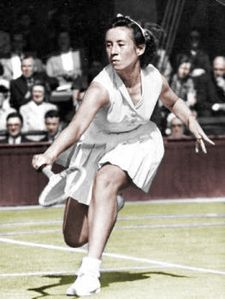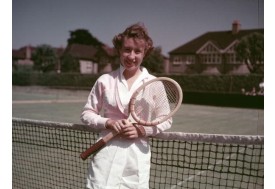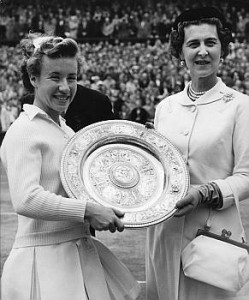Queens of the Court: The Brief, But Dominant Career of Little Mo

Maureen Connolly won nine of the 11 Grand Slam tournaments in which she competed.
“There is nothing like competition. It teaches you early in life to win and lose, and, when you lose, to put your chin out instead of dropping it.”
— Maureen Connolly
Although her career spanned just a little over four years, Maureen Connolly’s reign at the top of women’s tennis was one of the game’s most dominant.
Like many little girls growing up in America, Maureen Catherine (“Little Mo”) Connolly loved horses. She wanted a horse of her own and she wanted to learn how to ride. But family circumstances prevented Mo’s mother from being able to afford to give her little girl riding lessons.
Instead, her mother bought her the tennis racket she desired and enrolled her in lessons. Because of that, Maureen Connolly became a tennis player—perhaps the greatest tennis player her sport has ever known.
Growing up in California aided her development, as, in San Diego, weather was hardly ever an issue. At the tender age of 10, she learned to play on the municipal courts of the City of San Diego, where her first coach, Wilbur Folsom, encouraged the young Connolly to switch from a left-handed grip to a right. Connolly was a natural left-hander.
As a consequence, that change allowed her more power and accuracy, and with the blossoming of her strong backhand, Miss Connolly became a baseline specialist, having developed overpowering groundstrokes from both sides.
Once she established her game, Mo Connolly moved quickly into the rarefied air of champions. She came in second in the very first tournament she entered. Later, Connolly worked with world famous coach Eleanor “Teach” Tennant. Tennant had previously coached women’s champions Helen Wills Moody and Alice Marble.

Known as Little Mo, Connolly was 16-years-old when she won the U.S. Championship for the first time in 1951.
At age 14, she astounded the tennis world by winning 56 consecutive matches. She followed fast upon that feat by winning the U.S. National Championship for girls 18 and younger the following year.
In 1951, at the age of 16, Connolly became the youngest ever to win the U.S. Championships by defeating Shirley Fry in the final at the West Side Tennis Club in Forest Hills, NY. Remarkably, Connolly lost only four more matches during the rest of her career.
Expanding her tennis horizons in 1952, Connolly recaptured her U.S. Championship title and won Wimbledon for the first time. After she hired a new coach, Harry Hopman in 1953, Connolly decided she was ready to enter all four slam events.
Astoundingly, she won all four, making her the first woman ever to accomplish such a feat and the second person ever to win tennis’ Grand Slam—winning all four championships in a calendar year.
During the four tournaments, Connolly dropped just one set. On the way, she defeated Julie Sampson Haywood to win the Australian Championships and Doris Hart to win the French Championships, Wimbledon, and the U.S. Championships.
Connolly played aggressive all-court tennis, even though her strength remained rooted in her baseline game. She had tremendous foot speed. There were not many balls she could not reach and once she met the ball, the chances of it returning back over the net were slim.
Throughout her career, Little Mo was a fierce competitor. In The New York Times during her era, Allison Danzig once wrote, “Maureen with her perfect timing, fluency, balance and confidence, has developed the most overpowering stroke of its kind the game has ever known.”
In 1954, Connolly successfully defended her French and Wimbledon Championships, choosing not to go to Australia. She, of course, was planning to defend her title at the U.S. Championships later in the summer.

Just two weeks after claiming her third Wimbledon title in July 1954, Connolly's career was ended following a horse riding accident.
After attaining fame and fortune through tennis, Connolly was finally able to pursue her life-long love of being a horse-woman and she rode regularly now that money was no longer an issue. Her friends and neighbors presented her with a thoroughbred colt named Colonel Merryboy after Mo enjoyed a very successful European tour in 1952.
While riding Merryboy during that fateful summer in 1954, Little Mo passed close by a cement mixer truck. Her horse reared and Mo Connolly’s right leg was crushed as she was forced against the truck. Her leg was broken and she suffered with deep gashes affecting muscles and tendons.
Although there was initially hope of recovery, Little Mo would never play tennis again, and she was only 19 years of age. Connolly announced her retirement in February of 1955.
Her accomplishments in her brief career were staggering. She had won the last nine Grand Slam tournaments she had entered. This also included winning 50 singles matches.
- Australian Championships – Winner 1953
- French Championships – Winner 1953, 1954
- Wimbledon Championships – Winner 1952, 1953, 1954
- U.S. Championships – Winner 1951, 1952, 1953.
Because of her success and her youth, Connolly became a favorite with the media. She was the most popular female athlete of the year for three years between 1951-1953. Off-court, she remained approachable and friendly to the press.
She loved tennis yet recognized the darker side of professional athletics. Being at the top of the game meant that you were always a target on court and that everybody sought to bring you down.
The need to succeed and to win was part of being a champion, but it also brought out tremendous fear and anxiety in one so young.
She once remarked, “Tennis can be a grind and there is always the danger of going stale if you think about it too much. You can get embittered if you train too hard and have nothing else on your mind. You have to be able to relax between matches and between tournaments.”
The end of her tennis career, however, did not end Connolly’s association with tennis. She wrote and coached and, eventually with her husband Norman Brinker, formed the Maureen Connolly Brinker Foundation to promote junior tennis.
At the conclusion of her career, Connolly remarked, “Tennis is a wonderful game and I leave it with no regrets. I’ve had a full life with lots of travel and I’ve met lots of wonderful people…”
Connolly died at the age of 34 with stomach cancer. She left behind a tennis legacy highlighted with these facts: (1) She was ranked in the top 10 from 1951 through 1954; (2) She was ranked world No. 1 from 1952-1954; (3) She was inducted into the International Tennis Hall of Fame in 1969; and (4) She was inducted into the International Women’s Hall of Fame in 1987.
As stated previously a Grand Slam is defined as winning four majors in one calendar year. Maureen Connolly Brinker was the first woman ever to win a Grand Slam in women’s tennis. She did so in 1953.
The only other person to have accomplished this feat at the time was Don Budge on the men’s side in 1938. Rod Laver later won two Grand Slams in 1962 and in 1969 for the men.
Since Little Mo’s accomplishment in 1953, Margaret Court won the Grand Slam in 1970 and Steffi Graf added one in 1988, as well as winning the Olympic Gold Medal in tennis singles that year for a “Golden Grand Slam.”
The air is indeed rarefied for these superlative champions. Many have come close, but no one has accomplished a Grand Slam on the women’s side in over 20 years. Will it ever happen again? We wonder and wait…
[Quotes taken from www.nytimes.com in an article titled “On this Day, June 22, 1969.”]
Previous Queens of the Court articles by Clarabella Bevis and Claudia Celestial Girl:
JA Allen is a regular contributor to Sports Then and Now.
Have you considered adding several social bookmarking links to these blogs. At least for bebo.
Hello to all, the contents present at this web page are actually remarkable for people knowledge, well, keep up the good work fellows.
Pretty element of content. I just stumbled upon your blog and in accession capital to say that I acquire in fact loved
account your blog posts. Any way I will be subscribing for your feeds or even I success you get admission to persistently fast.
Thank you for every other excellent article. The place else may just anyone get that kind of
information in such a perfect method of writing?
I’ve a presentation next week, and I’m on the look for such info.
Make certain to look for markdowns when buying Auto Insurance
coverage, as a lot of providers offer savings for packing or secure
driving. Taking benefit of Auto Insurance coverage markdowns may substantially decrease your fee.